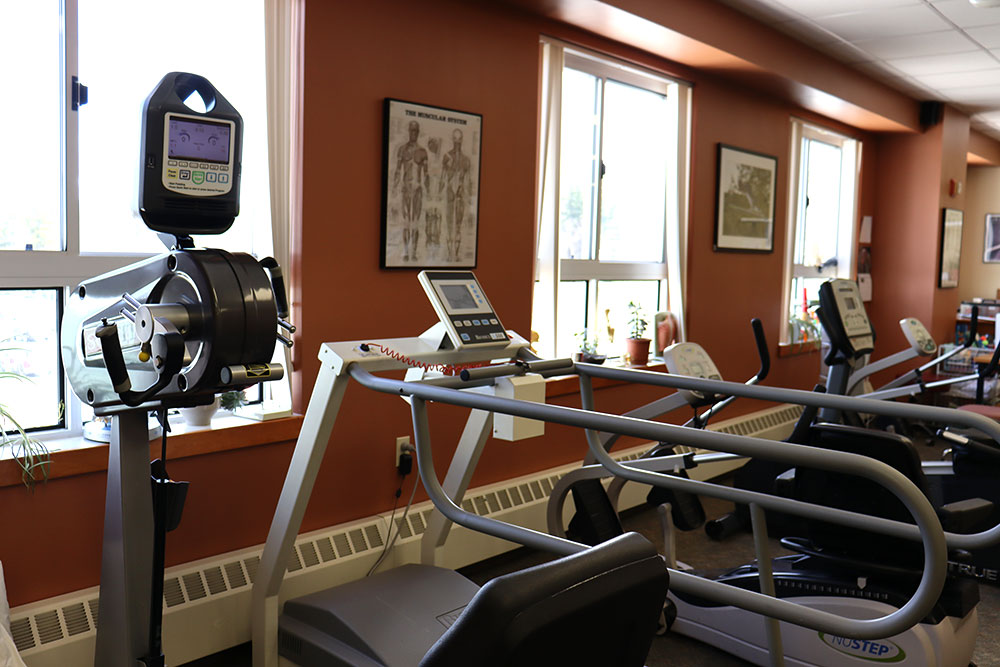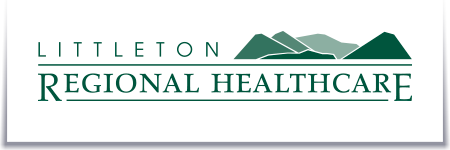Physical and Occupational Therapy services to develop, recover, or maintain the meaningful activities individuals want or need to do.
The Rehabilitation Services department treats disease, injury, and disability by assessment, examination, and use of rehabilitative procedures, mobilization, massage, exercises, and physical agents. The goal of the rehabilitation staff is to assist patients in achieving their maximum potential within their capabilities and to accelerate convalescence and reduce the length of functional recovery.
Contact Information
Rehabilitation Services
Littleton Regional Healthcare
600 St. Johnsbury Road
Littleton, NH 03561
603-444-9530
Fax 603-444-9361
Outpatient Hours:
Monday-Friday
7:00 AM-5:00 PM

Rehabilitation Services Offered
- Sports Rehabilitation
- Pediatric Rehabilitation/Early Intervention
- Pelvic Floor training
- Balance Training
- Gait training
- Splinting
- Activities of Daily Living/Self-care
- Therapeutic Exercise
- Home traction
- Biofeedback
- Contrast bath
- Fluidotherapy
- Paraffin/ Moist heat
- Vasopneumatic compression/ Cold
- Ultrasound
- Electrical stimulation/ TENS
- Iontophoresis
- Dry Needling
- Vestibular rehab
- Manual therapy
Rehabilitation Related Resources
More Information
What is the pelvic floor and what is its role?
The pelvic floor is made up of muscles, bony structures, fascia, ligaments, and blood, and nerve innervations, which have 3 functions:
- Support: provide support for the pelvic organs, bladder, uterus, and colon within the pelvis.
- Sphincter: assist in stopping and starting the flow of urine, gas, and bowel movements.
- Sexual: aid in sexual appreciation.
What is Incontinence?
- Involuntary loss/leakage of urine, gas, or feces; dysfunction in the voiding process
Are there different types of incontinence?
Urinary or Fecal Incontinence
- Stress-loss of urine during coughing, laughing, sneezing, walking, etc.
- The urge-urine loss that occurs with a strong desire to urinate (urgency) with a few seconds to minutes warning the bladder contracts when you do not want it to.
- Mixed-combination of both stress and urge incontinence.
- Overactive Bladder increased urinary urgency, frequency of urination, and urge-related
- Pelvic Relaxation (Pelvic Organ Prolapse) symptoms include post voiding dribble, falling out feeling, incomplete voiding. Childbirth is usually #1 risk factor, but chronic constipation/heavy lifting are also risk factors
Can men have incontinence, too?
- Yes, they can have the above types of incontinence, as well as incontinence related to prostate surgeries, interstitial cystitis, prostatitis, BPH, and muscle coordination dysfunction.
Can physical therapy help constipation?
- Yes, pelvic floor relaxation, massage, and education are all forms of treatment for normal voiding.
What other related diagnosis can physical therapy treat?
- Sexual dysfunction (painful intercourse/ejaculation, penile fracture, erectile dysfunction). Treatment may be focused on relaxation or strengthening the pelvic floor muscles and correct muscle coordination.
Do I need to see a specialist before coming to physical therapy?
- An obstetrician/gynecologist can refer women directly to physical therapy if the incontinence or pelvic pain is related to gynecology, pre/post-partum issues, or pelvic organ prolapse.
- A urologist can also refer men or women to therapy. A urodynamic evaluation will be performed to measure bladder filling, storage, and emptying. Other tests may include post-void residual, cystometry, EMG, cystography, video urodynamics, MRI.
- A PCP can refer a person to therapy; however, further, work-up is beneficial to have a more specific diagnosis.
What are “Kegal” exercises and are there different types of exercises?
- Kegal exercises= pelvic floor contractions: The physical therapist will work with a patient to isolate the correct muscles to work on relaxation, strength, endurance, and correct coordination for the correct function of the pelvic floor. Keywords used are “pulling up and in,” “squeeze as if you are holding back from voiding.” There are two different muscle fibers that are for separate functions; therefore there are two different exercises.
Fast Twitch muscles: “quick flicks”
to assist with holding back urine when you cannot get to the bathroom in time
- Slow-twitch muscles: “holding”
To strengthen and increase endurance during increased intraabdominal pressure (sneezing, coughing, laughing, and lifting)
Why perform “Kegels” (pelvic floor retraining) during pregnancy and post-labor?
- Strengthen the pelvic floor for more efficient pushing during contractions.
- Prevent incontinence during pregnancy (due to pressure of baby pressing down).
- Prevent urinary/bowel incontinence after labor.
What are the goals for treatment?
- Provide the patient with a better understanding of the pelvic floor and its function.
- Strengthen pelvic floor muscles with “kegel” exercises to decrease incontinence.
- Gain control of bladder function with the assistance of biofeedback and electrical stimulation.
- Retrain the bladder with normal voiding patterns.
- Decrease pelvic pain to resume functional lifestyles.
- Increase self-esteem and confidence to be independent without leakage.
Littleton Regional Healthcare Rehabilitation Services provides rehabilitation to children of all ages. Our dedicated team of therapists works to help each child reach their maximum capability.
Birth – 3 years old
Referrals can be in conjunction with or without Northern Family-Centered Early Supports and Services based in Conway, NH
3 years +
- Referrals made by a physician independently or to supplement school services
- Diagnoses include developmental delay or specific orthopedic or neurological impairment.
- The evaluation process for a pediatric client incorporates all areas of development to set goals appropriate for the child and family. Goals will be functional and family input is welcome and needed for the best outcomes.
- The physical and occupational therapists will work with the child and his/her family to assist with the normal developmental process by facilitating correct movement patterns and introducing new activities and tasks for the child to grow and learn.
- Families will be provided with a home exercise program and education needed to continue the progress at home.





